 Since Classical Times, doctors believed that the body contained four 'humours' that existed as liquids within the body - blood, phlegm, yellow bile and black bile - which were representative of air, water, fire and earth. If a patient was ill, it was because the body's humours had become unbalanced: if you had a temperature, you had a surfeit of blood and would need to be bled using a knife or leeches; if you were suffering from a cold, you had too much phlegm.
Since Classical Times, doctors believed that the body contained four 'humours' that existed as liquids within the body - blood, phlegm, yellow bile and black bile - which were representative of air, water, fire and earth. If a patient was ill, it was because the body's humours had become unbalanced: if you had a temperature, you had a surfeit of blood and would need to be bled using a knife or leeches; if you were suffering from a cold, you had too much phlegm.
It was believed that diseases were spread by bad smells or even by God's will acting on the humours, rather than by bacteria or viruses. Some doctors suggested that taking a bath should be avoided since it might upset the humours, so when Elizabeth I allegedly boasted that "I bathe once a month whether I need it or not", she believed by doing so she was taking her life in her hands. Instead, like most people, she would normally simply have a wash down to keep herself clean.
 Elizabeth was fortunate in that she could afford physicians who were usually well educated and highly qualified by the standards of the day. Those who could afford to might hire a barber surgeon (or surgeon) or an apothecary but the rest of the population would have to rely on a village 'wise woman' who was knowledgeable in herbs and potions, or might obtain a copy of the available medical books, including Gervase Markham's The Good Housewife which was first published in 1615. Others preferred to collect medical recipes to treat ailments, such as snail's milk to soothe a sore throat.
Elizabeth was fortunate in that she could afford physicians who were usually well educated and highly qualified by the standards of the day. Those who could afford to might hire a barber surgeon (or surgeon) or an apothecary but the rest of the population would have to rely on a village 'wise woman' who was knowledgeable in herbs and potions, or might obtain a copy of the available medical books, including Gervase Markham's The Good Housewife which was first published in 1615. Others preferred to collect medical recipes to treat ailments, such as snail's milk to soothe a sore throat.
However, changes were slowly taking place. In 1628 William Harvey discovered that blood circulates around the body, and better methods of stemming blood flow other than cauterising were found. It is difficult to say when the theory of the 'four humours' died out, because doctors were still 'bleeding' their patients in the early nineteenth century, and many of the potions used to cure people are still used today as the basis of medicines. Today we still talk about a 'stabbing pain' which dates back to the time when it was believed an invisible creature was stabbing its victim.
 Among the Loseley manuscripts (LM), held at Surrey History Centre, are some unusual remedies for a range of ailments, including a volume of culinary and medical recipes collected by Cassandra More Molyneux (1725 to 1777).
Among the Loseley manuscripts (LM), held at Surrey History Centre, are some unusual remedies for a range of ailments, including a volume of culinary and medical recipes collected by Cassandra More Molyneux (1725 to 1777).
Images
Select image to view a larger version.
- Cauterising and amputation tools, from John Woodall's The Surgeon's Mate, first published 1617 and reprinted several times during the 17th century. The wooden mallet and chisels are for amputating fingers and toes
- One of many 'cures' for the plague, 17th century (reference LM/1379/80, entry 57)
- As well as plants, parts of animals were used. Here we see the liver of hedgehog being used as an ingredient for 'fluxes of the bowel' and the heart of a frog for the 'collick'. 17th century (reference LM/1379/80, entries 117 and 118)

